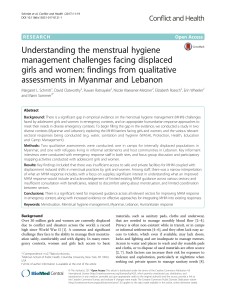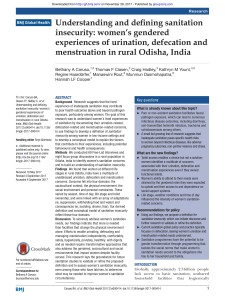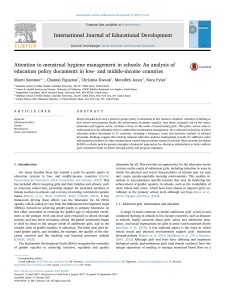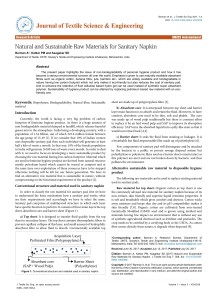Global Research Update #4
 Schmitt et al. (2017) in two qualitative assessments in Myanmar and Lebanon Understanding menstrual hygiene management challenges facing displaced girls and women finds that there are four main issues required to be addressed: 1) Changes in menstrual hygiene practices after displacement; 2) Inadequate, safe and private space for changing menstrual materials and disposal; 3) Insufficient guidance provided by response staff to beneficiaries on the basis of MHM; 4) Inadequate cross-sectional leadership and coordination on the content and training of MHM responses. This study also points out the importance of continuous consultation with girls and women for applying MHM responses according to their needs as well as cultural and local contextual background.
Schmitt et al. (2017) in two qualitative assessments in Myanmar and Lebanon Understanding menstrual hygiene management challenges facing displaced girls and women finds that there are four main issues required to be addressed: 1) Changes in menstrual hygiene practices after displacement; 2) Inadequate, safe and private space for changing menstrual materials and disposal; 3) Insufficient guidance provided by response staff to beneficiaries on the basis of MHM; 4) Inadequate cross-sectional leadership and coordination on the content and training of MHM responses. This study also points out the importance of continuous consultation with girls and women for applying MHM responses according to their needs as well as cultural and local contextual background.
 Caruso BA et al. (2017) in a qualitative study in rural Odisha, India Understanding and defining sanitation insecurity: Women’s gendered experiences of urination, defecation and menstruation realizes that sanitation insecurity is not solely on the basis of inaccessibility to facilities as because of expected family roles, women cannot fulfill their sanitation needs. So, sanitation insecurity is defined by four dimensions of socio-cultural context, physical environment, social environment and personal constraints and each of this issue contains gender as a central feature. Sanitation programs should include delivering messages that address sanitation constraints that women face due to their gender as well as socio-cultural environment.
Caruso BA et al. (2017) in a qualitative study in rural Odisha, India Understanding and defining sanitation insecurity: Women’s gendered experiences of urination, defecation and menstruation realizes that sanitation insecurity is not solely on the basis of inaccessibility to facilities as because of expected family roles, women cannot fulfill their sanitation needs. So, sanitation insecurity is defined by four dimensions of socio-cultural context, physical environment, social environment and personal constraints and each of this issue contains gender as a central feature. Sanitation programs should include delivering messages that address sanitation constraints that women face due to their gender as well as socio-cultural environment.
 Sommer M et al. (2017) in a policy review of twenty-one countries Attention to menstrual hygiene management in schools: An analysis of education policy documents in low- and middle- income countries finds that current education and gender policies provide inadequate explanation of MHM. The newly developed WASH guidelines in schools can be a practical example for education sectors to develop MHM related policies and programs in school settings.
Sommer M et al. (2017) in a policy review of twenty-one countries Attention to menstrual hygiene management in schools: An analysis of education policy documents in low- and middle- income countries finds that current education and gender policies provide inadequate explanation of MHM. The newly developed WASH guidelines in schools can be a practical example for education sectors to develop MHM related policies and programs in school settings.
 Barman A et al. (2017) in a scientific paper Natural and Sustainable Raw Materials for Sanitary Napkin discusses the global issue of usage of non-biodegradable menstrual products due to their contribution towards increasing emission of carbon footprint since by using disposable menstrual materials, each menstruating female would produce at least half a kilo of waste a month which can cause a serious environmental problem. To reduce this impact, the paper suggests shifting towards production of eco-friendly and sustainable menstrual hygiene products which have low carbon footprint. The author also takes menstruating female population in India as an example, and illustrates how this amount of population can damage the environment by just using reusable pads.
Barman A et al. (2017) in a scientific paper Natural and Sustainable Raw Materials for Sanitary Napkin discusses the global issue of usage of non-biodegradable menstrual products due to their contribution towards increasing emission of carbon footprint since by using disposable menstrual materials, each menstruating female would produce at least half a kilo of waste a month which can cause a serious environmental problem. To reduce this impact, the paper suggests shifting towards production of eco-friendly and sustainable menstrual hygiene products which have low carbon footprint. The author also takes menstruating female population in India as an example, and illustrates how this amount of population can damage the environment by just using reusable pads.

